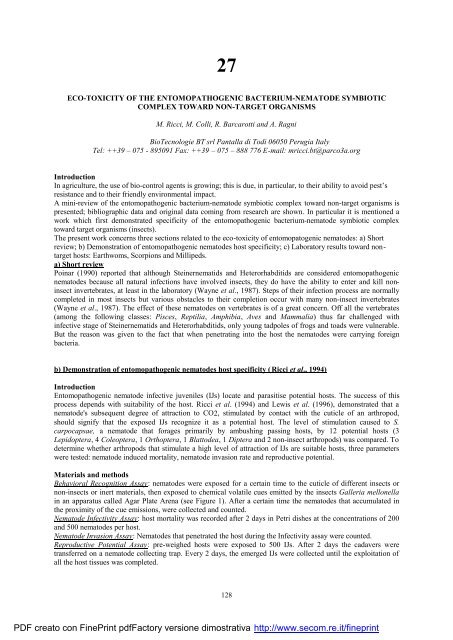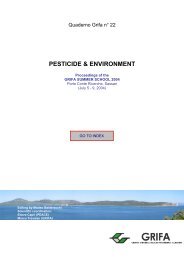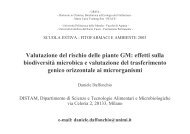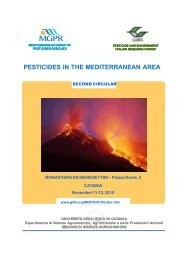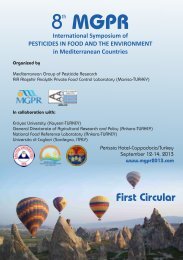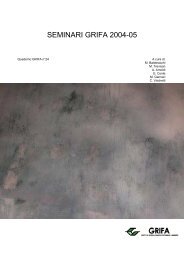International Congress BIOLOGICAL PRODUCTS - Gruppo di ...
International Congress BIOLOGICAL PRODUCTS - Gruppo di ...
International Congress BIOLOGICAL PRODUCTS - Gruppo di ...
You also want an ePaper? Increase the reach of your titles
YUMPU automatically turns print PDFs into web optimized ePapers that Google loves.
27<br />
ECO-TOXICITY OF THE ENTOMOPATHOGENIC BACTERIUM-NEMATODE SYMBIOTIC<br />
COMPLEX TOWARD NON-TARGET ORGANISMS<br />
M. Ricci, M. Colli, R. Barcarotti and A. Ragni<br />
BioTecnologie BT srl Pantalla <strong>di</strong> To<strong>di</strong> 06050 Perugia Italy<br />
Tel: ++39 – 075 - 895091 Fax: ++39 – 075 – 888 776 E-mail: mricci.bt@parco3a.org<br />
Introduction<br />
In agriculture, the use of bio-control agents is growing; this is due, in particular, to their ability to avoid pest’s<br />
resistance and to their friendly environmental impact.<br />
A mini-review of the entomopathogenic bacterium-nematode symbiotic complex toward non-target organisms is<br />
presented; bibliographic data and original data coming from research are shown. In particular it is mentioned a<br />
work which first demonstrated specificity of the entomopathogenic bacterium-nematode symbiotic complex<br />
toward target organisms (insects).<br />
The present work concerns three sections related to the eco-toxicity of entomopatogenic nematodes: a) Short<br />
review; b) Demonstration of entomopathogenic nematodes host specificity; c) Laboratory results toward nontarget<br />
hosts: Earthwoms, Scorpions and Millipeds.<br />
a) Short review<br />
Poinar (1990) reported that although Steinernematids and Heterorhab<strong>di</strong>tids are considered entomopathogenic<br />
nematodes because all natural infections have involved insects, they do have the ability to enter and kill noninsect<br />
invertebrates, at least in the laboratory (Wayne et al., 1987). Steps of their infection process are normally<br />
completed in most insects but various obstacles to their completion occur with many non-insect invertebrates<br />
(Wayne et al., 1987). The effect of these nematodes on vertebrates is of a great concern. Off all the vertebrates<br />
(among the following classes: Pisces, Reptilia, Amphibia, Aves and Mammalia) thus far challenged with<br />
infective stage of Steinernematids and Heterorhab<strong>di</strong>tids, only young tadpoles of frogs and toads were vulnerable.<br />
But the reason was given to the fact that when penetrating into the host the nematodes were carrying foreign<br />
bacteria.<br />
b) Demonstration of entomopathogenic nematodes host specificity ( Ricci et al., 1994)<br />
Introduction<br />
Entomopathogenic nematode infective juveniles (IJs) locate and parasitise potential hosts. The success of this<br />
process depends with suitability of the host. Ricci et al. (1994) and Lewis et al. (1996), demonstrated that a<br />
nematode's subsequent degree of attraction to CO2, stimulated by contact with the cuticle of an arthropod,<br />
should signify that the exposed IJs recognize it as a potential host. The level of stimulation caused to S.<br />
carpocapsae, a nematode that forages primarily by ambushing passing hosts, by 12 potential hosts (3<br />
Lepidoptera, 4 Coleoptera, 1 Orthoptera, 1 Blattodea, 1 Diptera and 2 non-insect arthropods) was compared. To<br />
determine whether arthropods that stimulate a high level of attraction of IJs are suitable hosts, three parameters<br />
were tested: nematode induced mortality, nematode invasion rate and reproductive potential.<br />
Materials and methods<br />
Behavioral Recognition Assay: nematodes were exposed for a certain time to the cuticle of <strong>di</strong>fferent insects or<br />
non-insects or inert materials, then exposed to chemical volatile cues emitted by the insects Galleria mellonella<br />
in an apparatus called Agar Plate Arena (see Figure 1). After a certain time the nematodes that accumulated in<br />
the proximity of the cue emissions, were collected and counted.<br />
Nematode Infectivity Assay: host mortality was recorded after 2 days in Petri <strong>di</strong>shes at the concentrations of 200<br />
and 500 nematodes per host.<br />
Nematode Invasion Assay: Nematodes that penetrated the host during the Infectivity assay were counted.<br />
Reproductive Potential Assay: pre-weighed hosts were exposed to 500 IJs. After 2 days the cadavers were<br />
transferred on a nematode collecting trap. Every 2 days, the emerged IJs were collected until the exploitation of<br />
all the host tissues was completed.<br />
PDF creato con FinePrint pdfFactory versione <strong>di</strong>mostrativa http://www.secom.re.it/fineprint<br />
128


